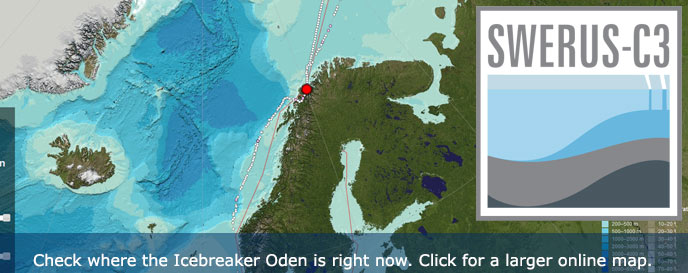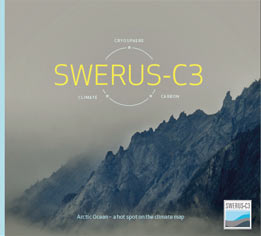|
After four years of intensive preparations, SWERUS-C3, a polar expedition to the East Siberian Arctic Ocean and its adjacent continental slope, finally kicked off on 5 July from Tromsø, Norway. Under a beating sun spirits were running high and a surge of excitement was taking hold of researchers and crew on board the icebreaker Oden.
When the flight from Stockholm touched down on Langnes airport in the morning of 4 July, wads of low-lying mist had engulfed the Tromsø fjord and temperatures were just above 10 degrees Celsius. The mountains that frame the picturesque city of Tromsø came in and out of view in just seconds and a gentle rain came down at times . The icebreaker Oden, which was anchored some 100 meters from the harbour, cast its reflection on the calm waters of the fjord.
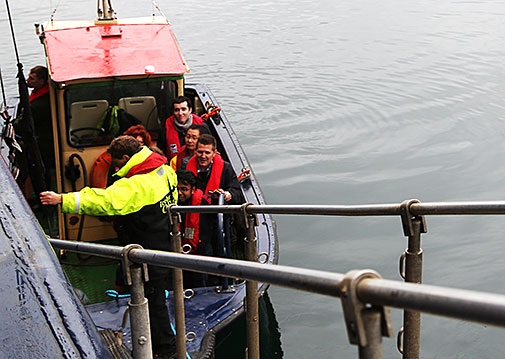
The reflection would often be torn in two by the motor of Oden’s small tender “Hugin” that ferried scientists and support personnel to and fro the ship.

Chief Scientist Örjan Gustafsson, Stockholm University confessed that he had “mixed feelings” when he boarded the icebreaker that morning. “ I felt a mixture of excitement, anticipation and nervousness but, overall, it’s such a great pleasure to finally arrive in Tromsø and to be on the Oden,” he said. He referred to Tromsø as “the getaway to the Arctic” from where expeditions by famous polar explorers like Roal Amudsen and Fridtjof Nansen set off. “Now it’s our turn. SWERUS-C3 is really ready to cast off!” he declared (video).
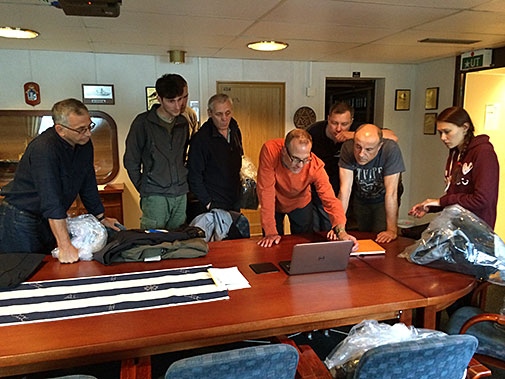
The expedition, which will operate in two consecutive 45-day-long stages (Leg 1 and 2) with a change-over in Barrow, Alaska, aims at understanding the interaction between the cryosphere, carbon and climate – hence the C3 acronym. More than 80 scientists from 14 countries take part in this expedition, which demanded immaculate planning and complicated logistics operations. “Earlier expeditions have found that enormous amounts of methane are being released into the atmosphere. The East Siberian Arctic Ocean holds vast quantities of submarine and coastal permafrost, which, in turn, stores huge amounts of carbon and methane. Very little is known about the stability of these methane bearing frozen layers,” said Örjan Gustafsson. His team will measure the amounts of carbon and methane in the air and seawater and will collect sediment samples to look for buried carbon. How much methane and how fast will it be released if/when permafrost begins to thaw?
Inside Oden the crew directed the newly arriving scientists to the cabin allocation list. Soon after that,
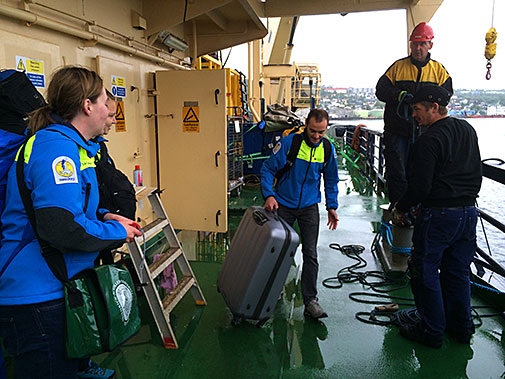
unpacking and chatting with roommates ensued. Those who had never been on the icebreaker before were given a tour around the ship while others went off to check whether or not their instruments survived the transit from Helsingborg. In the afternoon, it was time for the captain, Mattias Petersson, to inform the scientist about good housekeeping during the expedition.
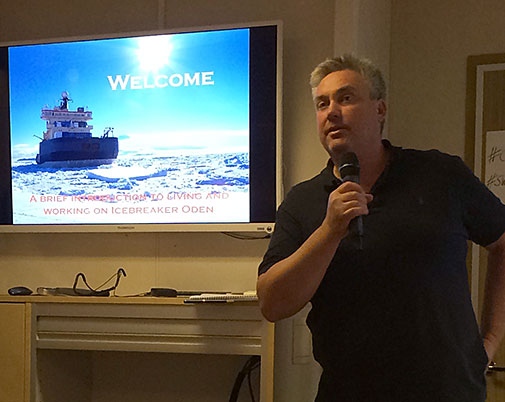
In a relaxed and entertaining presentation, he made clear that rules were in place to ensure everyone’s safety and wellbeing on the ship. After dinner many headed straight to bed. No chance to see the midnight sun anyway.
During the night the mist started to lift off the fjord. The participants woke up the next day to find clear skies and a warm sunshine. With just hours before departure, the tempo picked up quickly and one could occasionally feel the ship vibrating with each groan of the engines as they were tested. After breakfast, Emma Karlsson and Lisa Bröder, PhD students at Stockholm University headed to the storage containers to dig out clothes and personal items they had shipped from home. None of them has ever been on an expedition before or the Arctic Ocean.
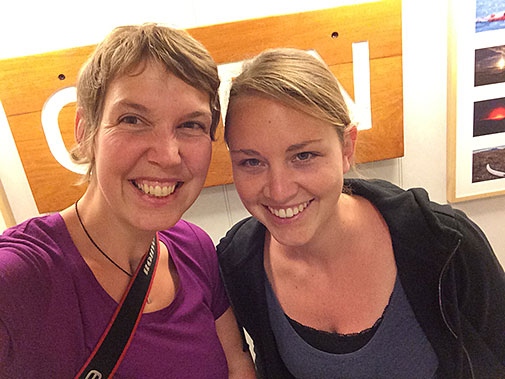
“It’s tricky to know what to expect. Sometimes you know what’s coming but once you step on the ship you’re like OK, what’s this going to be?” said Emma and turned to Lisa who nodded in agreement. Lisa thinks this expedition is a “social experiment.” “It’s not that you can take a walk in the woods when you need a break,” she said. She continued:“ We will be in a confined space with 70 other people for almost 7 weeks so it will be an interesting experience.” A tentative smile began to form on her face and the two went back to opening boxes (video).
A short distance away, Julia Steinbach, post-doctoral researcher at Stockholm University, was thoroughly inspecting her methane-extraction instruments. She had screwed them tightly onto her lab bench to avoid them being knocked off by the ship’s movements. She too has never been to the Arctic but has prior expedition experience, though, in a much warmer place, the Brazilian rainforest. “There is a lot of methane in the area we are going. If all this methane gets into the atmosphere it will contribute to an additional greenhouse effect,” said Julia.
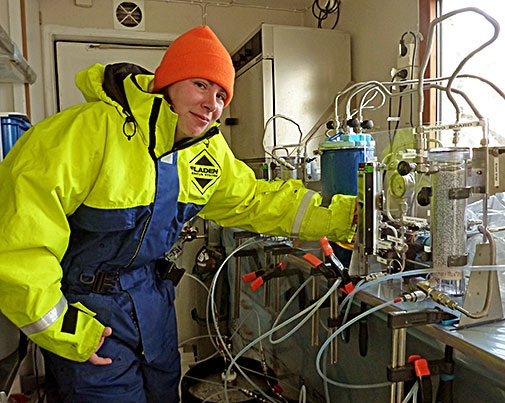
She hopes that SWERUS-C3 will find answers to some important scientific questions as well as being a valuable learning experience for all. “It feels really exciting! I’m looking forward to this expedition but I’m also apprehensive because it will get really intense.” Right then, her colleagues gave a low chuckle as they looked in our direction over their computer screens.
Finally, at 5pm after a final check of all systems on the ship, the crew drew up the anchor and the Oden hunched forward to begin its journey to the East Siberian Arctic Ocean. The mountains in the background were gleaming in the strong sunlight. Many were hanging out on the decks to absorb the scenery and the summer air for one last time. They won’t step on land until the change-over in Barrow. Or see much of the sun.
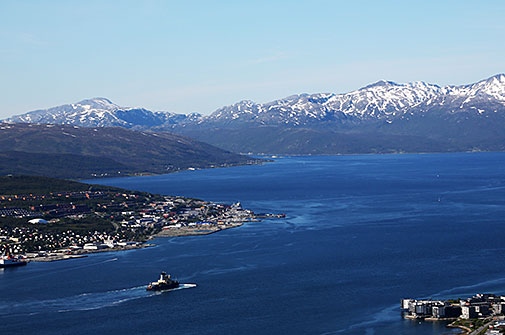
Goodbye Tromsø!
by Stella Papadopoulou, Department of Applied Environmental Science, Stockholm University
You want to know how Örjan, Emma, Lisa and Julia are getting on? Read their blogs.
To find out more about SWERUS-C3 go here
Follow the expedition on Facebook/Twitter/Youtube
|

